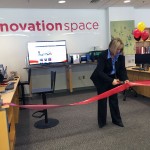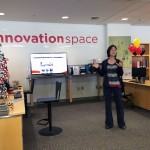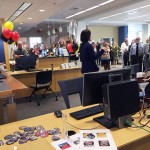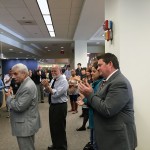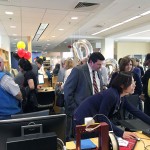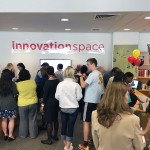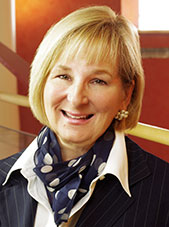
The HS/HSL has just completed its two-year 200th anniversary celebration. The two-year celebration commemorated the purchase of Dr. John Crawford’s collection to establish the Library in 1813 and the collection being made available for student use in 1815. The two years have flown by.
Looking back, here are some highlights.
- Dr. Phillip Mackowiak kicked off our celebration in May 2013 with a great talk on Dr. Crawford’s contribution to medicine. Afterwards, we walked to Westminster Graveyard to lay flowers on Dr. Crawford’s grave.
- We hosted excellent programs and exhibits. To name a few:
- Evolution and Influences: The Health Sciences and Human Services Library at 200. The exhibit is now permanently mounted on the wall in the fifth floor hall.
- WHACK’ed…and then everything was different. Artist Eliette Markhbein, a traumatic brain injured patient herself, traced her journey and exhibited her portraits of famous people with TBIs.
- Deadly Medicine: Creating the Master Race. This amazing exhibit created by the U.S. Holocaust Museum explored eugenics and Nazi abuse in their search to create a “master race.”
- We hosted visitors from Nairobi, Kenya, and Shanghai, China. Library faculty, Alexa Mayo and Ryan Harris also traveled to Nairobi as part of our exchange session with colleagues there.
- We celebrated the “Sweet Sixteen” birthday of our building.
- We introduced “Research Connection,” a suite of services to support research success at UMB through programs such as impact analysis, systematic reviews, and support for the NIH Biosketch.
- We launched a new HS/HSL strategic planning initiative that helped us learn a tremendous amount about our community’s needs, perceptions, and the value placed on the Library’s expertise, resources, and place. The plan will be published in Fall 2015.
- We launched our Innovation Space with 3D printers, a 3D scanner, and plans to expand.
- Our symposia series explored diverse topics such as scholarly communication, research impact, mHealth. We also launched “What’s Next?” our new series to explore the edges of health, healthcare, and the human condition.
What lies ahead?
In these fast moving times, it is hard to predict our “next big things.” However, solid guesses would include:
- A reduction in resources – With a flat resources budget, our ability to sustain our collections will be impossible. We will need to be creative in other areas such as interlibrary loan and document delivery to meet user needs quickly and conveniently.
- The completion of our strategic plan in fall 2015.
- E-publication of the history of the HS/HSL.
- Monitoring and adoption of new and emerging knowledge technologies.
- Physical changes to the library building, including expansion of the Innovation Space, a move to one service desk, changes in hours of operations, new furniture and perhaps some new uses for library spaces.
- An increasing focus on pedagogy and instructional design, data management, scholarly communication, and collaborative efforts, both at UMB and across the USM.
Thank You!
First, thanks to all who attended our programs, visited our exhibits, and supported our harebrained schemes. Thanks to all our private funders. The majority of our programming was provided gratis or funded by generous donors to the HS/HSL. And finally, very special thanks to the HS/HSL team who put together programs, edited copy, kept me from going over the edge, and served on a VERY effective Task Force 200, which planned all the events during our celebration.
Thank you…and onto our next 200 years!




 After listening to your suggestions at our Student Town Hall and through our Library Genie survey, we understand that you want more library hours. We are happy to announce that we can now offer early morning study from 6:00 a.m. to 8:00 a.m., Monday through Friday. For access to the HS/HSL before 8:00 a.m., simply enter through the SMC Campus Center with your UMB ID badge. Library services and access to classrooms begin at 8:00 a.m., when the HS/HSL’s front doors open. Occasionally, computers and printers will not be available during early morning study hours due to routine network updates.
After listening to your suggestions at our Student Town Hall and through our Library Genie survey, we understand that you want more library hours. We are happy to announce that we can now offer early morning study from 6:00 a.m. to 8:00 a.m., Monday through Friday. For access to the HS/HSL before 8:00 a.m., simply enter through the SMC Campus Center with your UMB ID badge. Library services and access to classrooms begin at 8:00 a.m., when the HS/HSL’s front doors open. Occasionally, computers and printers will not be available during early morning study hours due to routine network updates.
 Five preeminent medical libraries, including the HS/HSL, are collaborating on a project to digitize state medical journals. The Medical Heritage Library (MHL), is a digital resource on the history of medicine and health developed by an international consortium of cultural heritage repositories. The MHL has received funding in the amount of $275,000 from the National Endowment for the Humanities for its proposal, “Medicine at Ground Level: State Medical Societies, State Medical Journals, and the Development of American Medicine and Society.” Additional funding has been provided by the Harvard Library.
Five preeminent medical libraries, including the HS/HSL, are collaborating on a project to digitize state medical journals. The Medical Heritage Library (MHL), is a digital resource on the history of medicine and health developed by an international consortium of cultural heritage repositories. The MHL has received funding in the amount of $275,000 from the National Endowment for the Humanities for its proposal, “Medicine at Ground Level: State Medical Societies, State Medical Journals, and the Development of American Medicine and Society.” Additional funding has been provided by the Harvard Library.
 The HS/HSL opened its Innovation Space on Tuesday, April 21. We welcome all UMB students, faculty, and researchers who are interested in experimenting with 3D printing and 3D scanning. The HS/HSL will be developing the Innovation Space as a vibrant and collaborative hands-on learning space on campus and will be offering workshops and hosting talks in the future. The Innovation Space is equipped with two 3D printers (MakerBot Replicator 2X and Afinia H480), a 3D Systems Sense 3D scanner, Lynda.com video tutorials, a large DNA model, two molecule kits, and a button maker. The cost for 3D printing is $3.00 for up to an hour of 3D printing and $1.00 for each additional hour.
The HS/HSL opened its Innovation Space on Tuesday, April 21. We welcome all UMB students, faculty, and researchers who are interested in experimenting with 3D printing and 3D scanning. The HS/HSL will be developing the Innovation Space as a vibrant and collaborative hands-on learning space on campus and will be offering workshops and hosting talks in the future. The Innovation Space is equipped with two 3D printers (MakerBot Replicator 2X and Afinia H480), a 3D Systems Sense 3D scanner, Lynda.com video tutorials, a large DNA model, two molecule kits, and a button maker. The cost for 3D printing is $3.00 for up to an hour of 3D printing and $1.00 for each additional hour.
